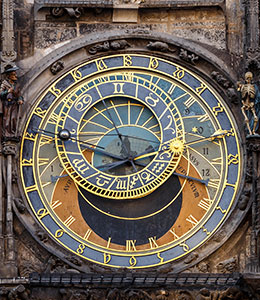Time is divided naturally by astronomical phenomena: the Earth’s rotation around the Sun and thus the recurring seasons, the phases of the moon, the succession of day and night.
To measure time in small divisions or units, man developed artificial methods such as the sun dial or clepsydra, a kind of clock that measured a flow of water. Since 1657 however, the use of oscillating systems in mechanical movements has enabled this task to be carried out more effectively.
The electronic revolution had a decisive influence in this process. In 1967, a Swiss research group designed and developed the first electronic watch movement, more commonly known as the quartz movement. This technology, using electrical energy from a battery, also paved the way for diode and subsequently liquid-crystal displays.
Quartz watches are extremely accurate thanks to their high vibration frequency (32 kHz). Their variation (running fast or slow) is less than one second per day.
By comparison, the frequencies of oscillations most commonly used in mechanical watches are in the order of 3 or 4 Hz, resulting in a daily variation of less than 10 seconds.


 Knowledge
Knowledge 